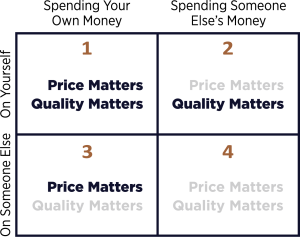
Incentives include possible rewards and/or penalties.


Capital determines whether a society will be prosperous or poor, well-fed or not, populated by independent and self-reliant citizens or dependent subjects. An abundance of nutritious food, clean water, sturdy homes, safe modes of transportation, reliable sources of heat and power, modern medicines, and many other products and technologies that improve the quality of human life are impossible without capital.
A teacher can help students understand what capital is by encouraging them to think of capital as an individual’s “starter pack” for being productive and getting things done. Capital includes the tools, money, and other valuable resources a person needs to create something of value, or to solve a problem in order to create wealth.
For example, if you wanted to start a lemonade stand, the money you use to buy cups, lemons, water, and a sweetener is capital. While money is an important form of capital, capital can include other resources that help you create wealth for yourself by producing value for others.
Other Kinds of Capital:
Capital is anything you can use to “build” something that will provide experiences of value for other people. Money is the most obvious example of capital, but creativity, friendships, and even your honesty and intelligence, can be just as important, maybe even more important in some circumstances.
So, yes! Capital is cash and more: Capital includes any resource that helps you be more productive. Ask students: What kinds of capital do they have? Maybe it is their energy, ideas, or even their ability to make people laugh. Remind them that everyone—even people with little or no money—have important capital over which each person has much control: A person’s own reputation, honesty, and trustworthiness.
Evaluating incentives
One of the most important questions within any society is: Who will allocate capital? One possibility is that individuals choose whether, how, when, where, and why to spend their own money and invest their own capital. Another option is that political elites within government will tax citizens and confiscate the wealth that others have created, and then those in government will choose how to allocate other people’s their capital.
Individuals choosing how to invest their own capital have strikingly different incentives than politicians and bureaucrats in government spending other people’s money.
As we discuss in another section, profit is the happiness of other people. When individuals and business owners make their own choices about how to allocate and when to invest their own capital, they aim to earn a profit—they want a return on their investment—which is another way of saying they’re trying to make other people happy by producing value for them.
When those in government choose how to spend other people’s money, they serve their own interests, usually by expanding the scope and power of government. That is worth repeating: Business owners allocate their own capital in order to make a profit for themselves by making other people happy; government allocates other people’s capital in order to extend the power and control of government.
Every new government spending program, after all, requires expanding the class of unelected bureaucrats, adding new levels of control over what citizens may do, and adding new kinds of taxpayer-funded government competition to businesses and other private organizations.
Incentives of Allocation
For politicians and bureaucrats, resource allocation often means achieving political ends or aiming for short-term gains. Without direct knowledge of costs or profits, these decisions can be quite unpredictable.
When private individuals choose how to invest or spend their own money, they have strong incentives to make careful, strategic decisions. If they invest wisely, they personally reap the rewards; if they invest foolishly, they suffer the losses. This direct link between decisions and consequences encourages efficiency and accountability. Individuals are motivated to seek the highest return (or best use) for their funds, and they also bear the risk of losing their capital if a project fails.
By contrast, when those in government take capital from citizens through taxation, politicians and bureaucrats end up allocating resources that are not their own. As a result, several distortions can arise:
In short, when individuals allocate their own funds, they have personal incentives—financial risk and reward—to be careful stewards of their capital. When governments collect taxes and decide how to spend them, officials are allocating other people’s funds and often do so under weak or no incentives for efficiency, with less direct accountability for mistakes, and with political or bureaucratic considerations that can overshadow the goal of maximizing societal well-being.
 Nº1
Nº1
Description
Download PDF Download ePub Button 3
Economists and other social scientists often emphasize that incentives matter to explain how individuals and organizations respond to the rewards or possible penalties associated with their actions.
Within businesses, for example, the incentive for profit is closely tied to efficiency, quality, and customer service. Owners and managers have strong motivations to minimize costs, maximize customer satisfaction, and innovate because their success depends on the ability to compete in the marketplace. Failure to deliver value leads to losses, bankruptcy, or being outperformed by competitors.
Government programs, however, operate in a different incentive structure. Since they are funded by taxpayer money and not subject to market competition, their survival and expansion are often influenced by political priorities rather than performance or efficiency. This can lead to perverse incentives—where programs grow regardless of whether they produce the results that were promised. Bureaucrats and administrators may focus on expanding budgets or meeting regulations rather than ensuring efficiency or accountability.
Understanding that incentives shape behavior helps explain why government programs are often inefficient, wasteful, and even counterproductive, while private businesses are driven to adapt and innovate under the pressures of competition.
The economist Milton Friedman developed an insightful and useful framework for understanding how people spend money, which are examples of the principle that incentives matter. Within Waypoints, we will call it Friedman’s Spending Matrix.
Friedman’s Spending Matrix categorizes spending into four types based on two key dimensions:
1. Whose money is being spent? (Your own money or someone else’s money)
2. Who benefits from the spending? (You or someone else)
– Example: Buying groceries for yourself.
– Incentives: People are careful to maximize value because they care about both cost and quality.
– Efficiency: Typically the most efficient and careful type of spending.
– Example: A young adult choosing which university to attend, and the parents have promised to pay the tuition.
– Incentives: Tendency to prioritize quality over cost because the individual making the choice is not spending his own money.
– Efficiency: Often inefficient, as the spender may indulge without regard for cost.
– Example: Buying a gift for a friend.
– Incentives: Cost-conscious, but less attentive to the quality of the purchase because the person buying the product is not the one who will own and use it.
– Efficiency: Moderately efficient.
– Example: Government spending taxpayer dollars on programs that provide subsidies for other people.
– Incentives: Minimal concern for both cost and quality, as neither impacts the spender directly. In this example, those in government don’t care what the cost is because they are spending other people’s money; those in government also don’t care about the quality of whatever is being purchased because they will not own or use what is purchased.
– Efficiency: The least efficient type of spending due to lack of direct accountability.

Applications and Importance
– Public Policy: Friedman used this framework to critique government spending, arguing that inefficiency is inherent when policymakers spend taxpayer money on others.
– Economics and Incentives: The matrix illustrates the importance of incentives and accountability in spending decisions, reinforcing the value of free markets individuals choosing how to spend their own money and how best to allocate their own capital.
– Education and Advocacy: The simplicity of the model makes it a powerful tool for teaching economic principles and discussing government spending, debt, and the frequent lack of results from government programs.
Friedman’s matrix highlights the natural trade-offs and distortions in decision-making when incentives change. It underscores the inefficiencies of government intervention and the importance of personal responsibility and market-driven spending.
It is helpful to remember that Quadrant 4 choices are typically the worst quality of choices—and that all government spending programs are Quadrant 4 choices. From these principles, a rule of thumb follows: When something doesn’t seem to make sense, or a program receives more funding even though it doesn’t achieve the results that have been promised, government is usually involved either directly or indirectly.
 Nº1
Nº1